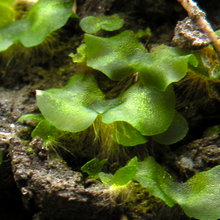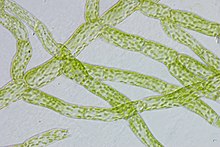HJ Mitchell (
talk |
contribs)
m Reverted edits by
208.68.154.209 to last version by Nadiatalent (
GLOO) |
|||
| Line 18: | Line 18: | ||
==See also== |
==See also== |
||
my genitalia |
|||
*[[Sporophyte]] |
*[[Sporophyte]] |
||
*[[Alternation of generations]] |
*[[Alternation of generations]] |
||
Revision as of 19:18, 7 November 2011


A gametophyte is the haploid, multicellular phase of plants and algae that undergo alternation of generations, with each of its cells containing only a single set of chromosomes.
The gametophyte produces male or female gametes (or both), by a process of cell division called mitosis. The fusion of male and female gametes produces a diploid zygote, which develops by repeated mitotic cell divisions into a multicellular sporophyte. Because the sporophyte is the product of the fusion of two haploid gametes, its cells are diploid, containing two sets of chromosomes. The mature sporophyte produces spores by a process called meiosis, sometimes referred to as " reduction division" because the chromosome pairs are separated once again to form single sets. The spores are therefore once again haploid and develop into a haploid gametophyte.
In mosses, liverworts and hornworts ( bryophytes), the gametophyte is the commonly known phase of the plant. An early developmental stage in the gametophyte of mosses (immediately following germination of the meiospore) is called the protonema. The adult gametophyte of mosses is called the gametophore as it carries the gamete-producing sex organs. [1]
In most other land plants, the gametophyte is very small. In ferns the gametophyte is a free living organism called the prothallus, in contrast to angiosperms. [2]
In gymnosperms and angiosperms, the gametophyte are reduced to only a few cells; in angiosperms the female gametophyte (sometimes called the "embryo sac") is known as a megagametophyte and the male gametophyte ( pollen) is called a microgametophyte.
In some multicellular green algae, red algae, or brown algae (Ulva is one example), the sporophytes and gametophytes are often isomorphic, but in some species the gametophyte may be reduced.
References
- ^ Ralf Reski(1998): Development, genetics and molecular biology of mosses. In: Botanica Acta 111, pp 1-15.
- ^ C.Michael Hogan. 2010. Fern. Encyclopedia of Earth. National council for Science and the Environment. Washington, DC
See also
my genitalia
HJ Mitchell (
talk |
contribs)
m Reverted edits by
208.68.154.209 to last version by Nadiatalent (
GLOO) |
|||
| Line 18: | Line 18: | ||
==See also== |
==See also== |
||
my genitalia |
|||
*[[Sporophyte]] |
*[[Sporophyte]] |
||
*[[Alternation of generations]] |
*[[Alternation of generations]] |
||
Revision as of 19:18, 7 November 2011


A gametophyte is the haploid, multicellular phase of plants and algae that undergo alternation of generations, with each of its cells containing only a single set of chromosomes.
The gametophyte produces male or female gametes (or both), by a process of cell division called mitosis. The fusion of male and female gametes produces a diploid zygote, which develops by repeated mitotic cell divisions into a multicellular sporophyte. Because the sporophyte is the product of the fusion of two haploid gametes, its cells are diploid, containing two sets of chromosomes. The mature sporophyte produces spores by a process called meiosis, sometimes referred to as " reduction division" because the chromosome pairs are separated once again to form single sets. The spores are therefore once again haploid and develop into a haploid gametophyte.
In mosses, liverworts and hornworts ( bryophytes), the gametophyte is the commonly known phase of the plant. An early developmental stage in the gametophyte of mosses (immediately following germination of the meiospore) is called the protonema. The adult gametophyte of mosses is called the gametophore as it carries the gamete-producing sex organs. [1]
In most other land plants, the gametophyte is very small. In ferns the gametophyte is a free living organism called the prothallus, in contrast to angiosperms. [2]
In gymnosperms and angiosperms, the gametophyte are reduced to only a few cells; in angiosperms the female gametophyte (sometimes called the "embryo sac") is known as a megagametophyte and the male gametophyte ( pollen) is called a microgametophyte.
In some multicellular green algae, red algae, or brown algae (Ulva is one example), the sporophytes and gametophytes are often isomorphic, but in some species the gametophyte may be reduced.
References
- ^ Ralf Reski(1998): Development, genetics and molecular biology of mosses. In: Botanica Acta 111, pp 1-15.
- ^ C.Michael Hogan. 2010. Fern. Encyclopedia of Earth. National council for Science and the Environment. Washington, DC
See also
my genitalia